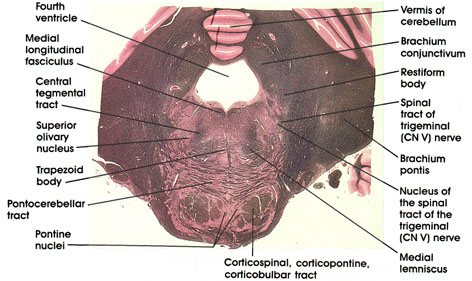

Plate 17.333 Pons
Ronald A. Bergman, Ph.D., Adel K. Afifi, M.D., Paul M. Heidger,
Jr., Ph.D.
Peer Review Status: Externally Peer Reviewed

Human, 10% formalin, Pal-Weigert, 2.5 x.
Vermis of the cerebellum: Overlying the fourth ventricle. Midline portion of cerebellum.
Medial longitudinal fasciculus: Continuation of the same structure seen at more caudal levels. Concerned with ocular movement in response to vestibular stimulation.
Central tegmental tract: Compact fiber bundle located dorsal to the medial lemniscus. Carries fibers from midbrain tegmenturn, red nucleus, and periaqueductal gray matter to the inferior olivary complex.
Superior olivary nucleus: One of the tegmental nuclei that belong to the cochlear system. Receives fibers from the trapezoid body and contributes to the formation of the lateral lemniscus.
Trapezoid body: Also known as the inferior acoustic stria. Axons of neurons in the inferior cochlear nucleus form the trapezoid body.
Pontocerebellar tract: Axons of pontine nuclei on their way to the cerebellum via the brachiurn pontis.
Pontine nuclei: Scattered between the descending corticospinal, corticopontine, and corticobulbar fibers and the horizontally oriented pontocerebellar fibers. Receive input from the cerebral cortex via the corticopontine tract and project to cerebellum via the pontocerebellar tract.
Brachium conjunctivum: Also known as the superior cerebellar peduncle. Most important efferent fiber system of the deep cerebellar nuclei. Located dorsolateral to the fourth ventricle. Later in its course, it dips into the tegmenturn of the pons and midbrain (see Plates 337, 338 and 339). Nerve fibers in this bundle are destined to reach the contralateral red nucleus and ventrolateral nucleus of the thalamus.
Restiform body: Also known as the inferior cerebellar peduncle. Continuation of the same fiber system seen at more caudal levels. The restiform body is shown here entering the cerebellum.
Brachium pontis: A massive bundle of fibers connecting the basal portion of the pons with the cerebellum. Also known as the middle cerebellar peduncle. Contains pontocerebellar tract.
Spinal tract and nucleus of trigerninal nerve: Continuation of the same structures described at caudal levels.
Medial lemniscus: Continuation of the same fiber system described at more caudal levels (see Plates 329, 330 and 331). Note change in orientation of fibers from (previously) vertical in medulla oblongata to horizontal here in the pons.
Corticospinal, corticopontine, corticobulbar tracts: Descending fiber system sectioned transversely. Destined for the pontine nuclei, cranial nerve nuclei, and the spinal cord motoneurons.
Next Page | Previous Page | Section Top | Title Page
Please send us comments by filling out our Comment Form.
All contents copyright © 1995-2025 the Author(s) and Michael P. D'Alessandro, M.D. All rights reserved.
"Anatomy Atlases", the Anatomy Atlases logo, and "A digital library of anatomy information" are all Trademarks of Michael P. D'Alessandro, M.D.
Anatomy Atlases is funded in whole by Michael P. D'Alessandro, M.D. Advertising is not accepted.
Your personal information remains confidential and is not sold, leased, or given to any third party be they reliable or not.
The information contained in Anatomy Atlases is not a substitute for the medical care and advice of your physician. There may be variations in treatment that your physician may recommend based on individual facts and circumstances.
URL: http://www.anatomyatlases.org/